Cite this document
(“Security in the Cloud Essay Example | Topics and Well Written Essays - 2000 words”, n.d.)
Security in the Cloud Essay Example | Topics and Well Written Essays - 2000 words. Retrieved from https://studentshare.org/information-technology/1479691-security-in-the-cloud
Security in the Cloud Essay Example | Topics and Well Written Essays - 2000 words. Retrieved from https://studentshare.org/information-technology/1479691-security-in-the-cloud
(Security in the Cloud Essay Example | Topics and Well Written Essays - 2000 Words)
Security in the Cloud Essay Example | Topics and Well Written Essays - 2000 Words. https://studentshare.org/information-technology/1479691-security-in-the-cloud.
Security in the Cloud Essay Example | Topics and Well Written Essays - 2000 Words. https://studentshare.org/information-technology/1479691-security-in-the-cloud.
“Security in the Cloud Essay Example | Topics and Well Written Essays - 2000 Words”, n.d. https://studentshare.org/information-technology/1479691-security-in-the-cloud.


